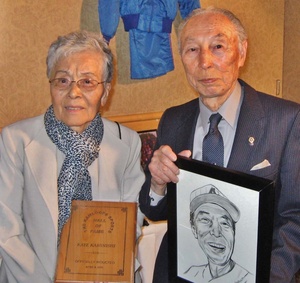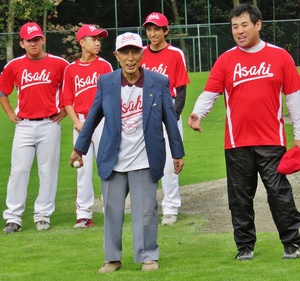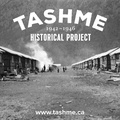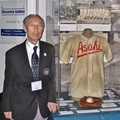Kaye’s baseball career did not just end with the disbanding of the Vancouver Asahi. Kaye and his mother were evacuated to East Lillooet, one of the first self-supporting internment camps. Internees in self-supporting camps received no government support. For the first year, life was very hard, as the internees had to build their own homes and households in very primitive camp conditions. Camp internees were restricted from entering the town of Lillooet, which was across the Fraser River. The bridge across the river was the only link to Lillooet and the internees required a permit to cross the bridge.
Soon after he arrived in the East Lillooet internment camp, Kaye organized a softball team among the residents of the camp and was looking for more opportunities to play. The RCMP detachment in Lillooet was responsible for ensuring that the regulations of the BC Security Commission were upheld. RCMP officers often visited the internment camp to check on camp conditions. On one of these visits, Kaye approached an officer to propose that the East Lillooet softball team play a Lillooet team in an exhibition match. The officer thought that this was a good idea and gladly accepted the challenge.
Exhibition games between the Japanese and a team in Lillooet opened up interactions between the two distinct communities. The merchants in Lillooet were excited by the new opportunities that the Japanese afforded. Until then, Lillooet was a dying community. The Japanese had cash to spend. So the game of baseball created a bridge to a new social and economic relationship that benefitted everyone.
At the end of the war and internment, at age 25, Kaye was anxious to get on with his life and continue playing baseball. He moved to Kamloops where he found employment and a church baseball team to play for. He was the only Japanese person on the team. He played third base in Kamloops for several years, first with the Kamloops CYO in the Interior League, then the Elks in the Okanagan Valley League. After his playing days ended in 1954, he coached young players in Little League, then retired from baseball entirely. For Kaye, baseball took a backseat to life and raising a family.
As Kaye tells it, the resurrection of the Asahi story began with the 1992 publication of Pat Adachi’s excellent book Asahi: A Legend in Baseball, which was a tribute to the team and its people: the founders, players, coaches, and managers. The Asahi story, a tribute to overcoming adversity in the face of the racial and economic discrimination that an ethnic group encountered on a daily basis at the time, captured the imagination of many.
Jari Osborne, a National Film Board filmmaker, produced the movie Sleeping Tigers: The Asahi Baseball Story, which premiered at the Nikkei National Museum and Cultural Centre in 2003. A nomination to Canada’s Baseball Hall of Fame spearheaded by a group in Toronto, including Pat Adachi, led to the team’s induction into the Hall of Fame in 2003. Grace Eiko Thomson curated the 2005 NNMCC exhibit called Leveling the Playing Field: Legacy of Vancouver’s Asahi Baseball Team, an exhibit that also toured Canada. The team was inducted into the BC Sports Hall of Fame in 2005. Journalists in Japan took a strong interest in the story and wrote newspaper and magazine articles as well as books in Japanese for an audience who had little or no knowledge about the Asahi, but who were captivated by the story of overcoming adversity. In 2014, a Japanese film studio released the movie Vancouver Asahi, a fictionalized period drama based on the Asahi story. This film premiered at the 2014 Vancouver International Film Festival and won its People’s Choice award.
While the resurrection of the Asahi story was happening in Canada, Kaye recalls a similar story about captivating audiences in Japan. In the summer of 1992, shortly after Pat Adachi published her book, Kaye and his wife were on a Gray Line tour bus touring Vancouver, showing relatives from Japan the sights of Vancouver. When the bus passed Oppenheimer Park, Kaye told his relatives that the Asahi played baseball on that field. Another tourist from Japan on the bus overheard the conversation and very excitedly approached Kaye to find out more. Mr. Norio Goto, who was a media announcer with the Japanese professional baseball team the Nagoya Chunichi Dragons, was that tourist. Mr. Goto was so enthralled by the Asahi story that he returned to Japan to organize a project to tell the Asahi story to the Japanese audience. Two years later he and a 5-person film crew returned to Canada to research the history of the Asahi baseball team and film interviews with Kaye, other former Asahi players, and Pat Adachi. The resulting film, which described the Asahi in the context of the history of the Japanese in Canada, was shown in prime time to a wide Japanese audience. Mr. Goto also wrote a book, The Vancouver Asahi Monogatari (Story), which was published in 2010. In 2014, a manga series of five issues called The Vancouver Asahi Story was published. Kaye and Mr. Goto remain strong friends to this day.
Several baseball teams playing today have honored the Asahi as a role model for overcoming racial and economic discrimination and a metaphor for living in today’s diverse society. On May 15, 2002, the Asahi and four of its original players were honored before a Blue Jays game at Toronto’s Skydome. On more than one occasion, most recently on August 10, 2015, the Vancouver Canadians have honoured the team and asked Kaye to throw the ceremonial first pitch at Nat Bailey Stadium in Vancouver where a large wall mural of the Asahi is on display. Signage honouring the team is also on display at Oppenheimer Park.
Formation of the Canadian Nikkei Youth Baseball Club is another legacy inspired by the Asahi baseball story. Consisting of 200 members and 80 players making up five Shin (new) Asahi teams, in five age categories from age nine to adult, they play Asahi-style baseball in exhibition and tournament play in the greater Vancouver area every summer. As an honorary founding member of the club, Kaye is an inspiration to the young players who come from diverse backgrounds and have a common interest: playing baseball.
These events have brought the Asahi back to life and Kaye could not be more delighted.
Kaye, as the last living Asahi team member, continues to be asked for interviews. He is humbled by all the attention. “This all happened over 70 years ago. I was just a kid who was good enough to be selected to play for the Asahi. I think I was the youngest on the team, and I played for only two seasons. My career with the Asahi was over before I was 20,” he says, with more than a touch of bewilderment in his voice.
Kaye often reflects on his good fortune to have been chosen to play for the Asahi and for his good health that has enabled him to participate in the many events honouring the team since the publication of Pat Adachi’s book. He says that he is often overcome by an overwhelming sense of the pride that he imagines his parents, the ancestors of the Asahi players, and the entire Japanese community must be feeling now. He is also saddened that his parents and the parents of Asahi players are not able to share in the limelight of the Asahi story’s retelling.
Until a few years ago, Kaye played competitive level badminton. He participated in the BC Senior Games for more than 20 years. With his partner Herb Pendell from Salmon Arm, BC, they captured first place in the men’s doubles category for 10 consecutive years from 1971 to 1980. In 1995, he and his partner won second place in men’s doubles at the All American Senior Games tournament in San Antonio Texas. In a recent interview about his participation in the BC Games he said, “I’ve got about 25 medals,” pointing to a display on a wall in his home in Kamloops. “I used to play singles, doubles, and mixed doubles. Now I just play men’s doubles. I'm taking it easy.”
“Sports has been really good to me.”
*This article was originally published in the Nikkei Images (Winter 2015, Volume 20, No. 3), a publication of the Nikkei National Museum & Cultural Centre.
© 2015 Howard Shimokura






